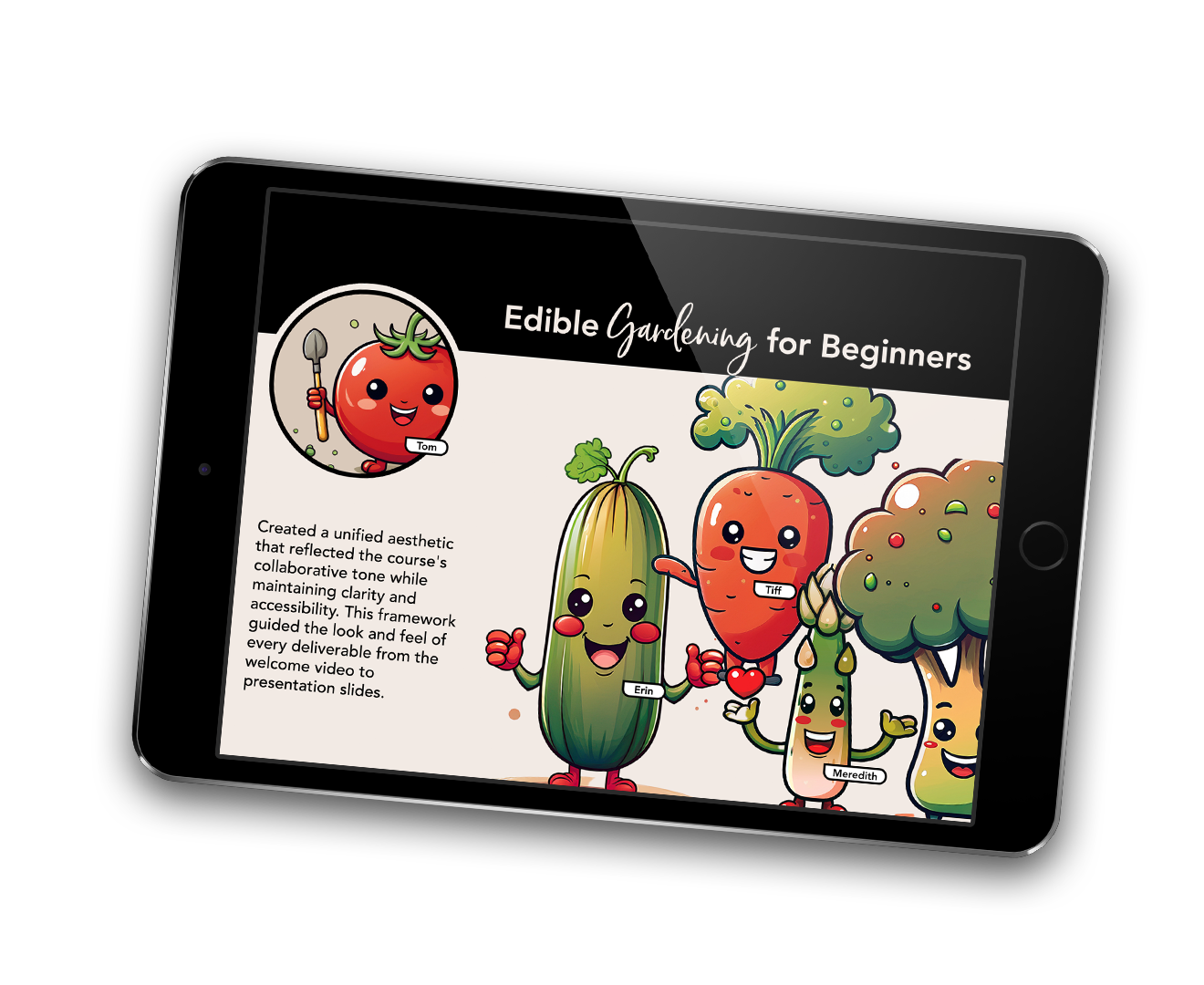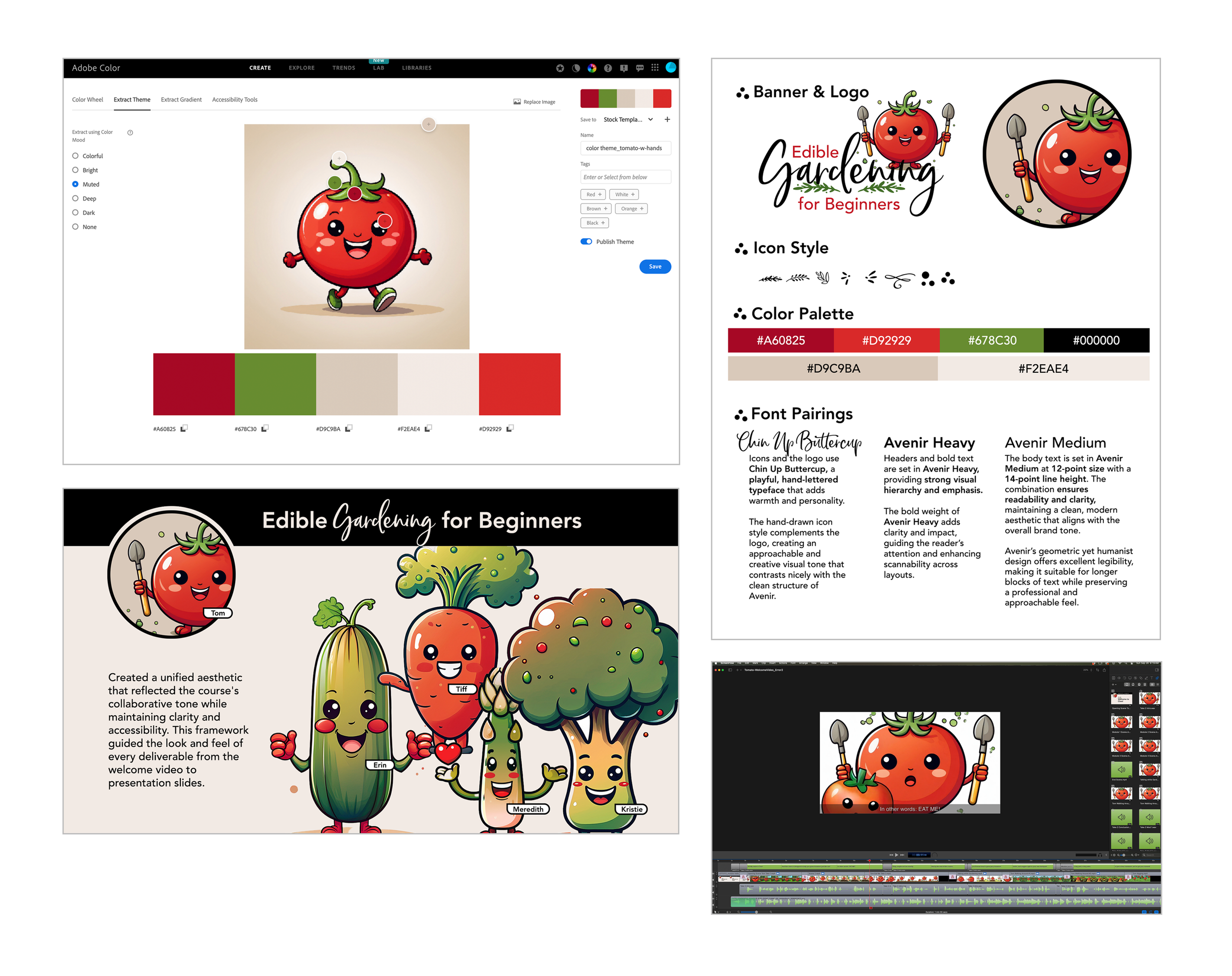
Edible Gardening for Beginners
MULTIMEDIA DESIGN
As part of my graduate training in Instructional Design, my group was tasked with creating a two-minute welcome video to introduce learners to an online course titled Edible Gardening for Beginners.
Unlike typical introduction videos that focus on outlining expectations or previewing content, I believe welcome videos should spark curiosity, build connection, and invite learners into the experience.
After my team agreed that I would lead the visual design, video editing, and post-production for the project, my goal was to design a piece that felt warm, authentic, and visually cohesive: one that introduced the course not only through information, but through tone, personality, and design.
PROJECT DETAILS
Roles: Visual & Video Editing Design
Brief: Creation of a 2-minute welcome video based on a fictional gardening class for beginners.
TOOLS
Telestream Screenflow.
Adobe Photoshop.
AI Image Generation.
Closed Captioning Tools.
SKILLS
Multimedia design & video editing.
Instructional storytelling.
Collaboration & project leadership.
Accessibility & inclusive design.
Final Project
Design Notes & Rationale
-
The project required transforming a written script and various team-created media assets including 3 to 5-second AI-generated animations, voiceovers, and still images into a cohesive, learner-centered multimedia experience.
I served as the lead visual and video designer, responsible for shaping the overall creative direction, developing the course branding (logo, avatar as “vegetars”, style sheet), and ensuring the final product reflected both the instructional intent and atheistic unity.
My work involved integrating and editing short AI-generated clips, synchronizing character movement with narration, designing and layering background audio with ducking for clarity, and developing closed captioning to meet accessibility standards.
In addition to technical production, I collaborated closely with team members to align visual, narrative, and pedagogical elements, ensuring that the finished video effectively welcomed learners, introduced the instructional content, and modeled the course’s emphasis on approachability, inclusion, and visual storytelling through humor.
-
I began the design process by developing the course’s visual identity: a cohesive style sheet outlining color palette, typography, and iconography that conveyed warmth, clarity, approachability, and humor.
I generated the initial “vegetar” character concepts using AI image generation tools, then refined and standardized them in Adobe Photoshop to establish a unified art style.
During video production, I used Telestream Screenflow to align motion, audio, and narrative pacing, syncing the vegetar’s movements with voiceovers and layering background music with audio ducking.
Each design decision supported learner engagement, accessibility, and emotional connection, translating the course’s instructional goals into a polished, story-drive visual experience.
Outcomes
My favorite part of this experience was coordinating and communicating with my team. I have always enjoyed fitting different aspects of the creative process together while leading cross-teams to build a completely brand new, polished project. I think learners today want to immerse themselves into and engage with multimedia so I aim to make those connections visually and emotionally. I think, as a team, we accomplished that goal and I'm proud of the project we created together.
The final video successfully combined visual storytelling and instructional design to create an engaging and welcoming introduction for learners. The project demonstrated the value of collaborative multimedia development, where clear communication and creative coordination produced a cohesive result despite distributed team roles and tools.
Through this process, I strengthened my proficiency in AI-assisted media production, video editing, and accessibility integration, while refining my ability to translate instructional intent into compelling human-centered design.


